warning PORSCHE 911 TURBO 2014 6.G Owners Manual
[x] Cancel search | Manufacturer: PORSCHE, Model Year: 2014, Model line: 911 TURBO, Model: PORSCHE 911 TURBO 2014 6.GPages: 300, PDF Size: 10.61 MB
Page 223 of 300

Maintenance and Car Care 221
Radiator fan, engine compartment blowers
The engine-compartment blowers are mounted under the engine compartment lid.After the engine is switched off, the engine compartment temperature is monitored for approx. 30 minutes.During this period, and depending on temperature, the engine-compartment blowers may continue to run or start to run.fCarry out work in this area only with the engine off and exercise extreme caution.
The radiators and radiator fans are in the front of the vehicle.The radiator fans in the front of the vehicle may be operating or unexpectedly start operating when the engine is switched on.fCarry out work in these areas only with the engine switched off.fTake great care to ensure that parts of the body, items of clothing or jewelery cannot be drawn in by the radiator fan, engine-compartment blower, drive belt or other moving parts.
Measurements on test stands
Performance test
Performance tests on roller-type test stands are not approved by Porsche.
Brake tests
Brake tests must be performed only on roller-type test stands.
The following limit values must not be exceeded on roller-type test stands: – Test speed 4.7 mph (7.5 km/h)– Test duration 20 seconds
Testing the electric parking brake
Electric parking brake tests on the brake test stand must only be performed with the ignition switched on and with the Porsche Doppelkupplung selector lever in position N. The vehicle switches automatically to brake test stand mode, in which the electric parking brake can be tested.The message “ Electric parking brake in service mode ” appears on the multi-function display in the instrument panel.
Balancing wheels on the vehicle
During finish balancing of the wheels, the entire vehicle must be lifted and the wheels must be free to turn.
Engine Oil
It is important to perform oil changes regularly in accordance with the intervals specified in your Maintenance Schedule .
Engine oil consumption
It is normal for your engine to consume oil. The rate of oil consumption depends on the quality and viscosity of oil, the speed at which the engine is operated, the climate, road conditions as well
as the amount of dilution and oxidation of the lubricant.
If the vehicle is used for repeated short trips, and consumes a normal amount of oil, the engine oil measurement may not show any drop in the oil level at all, even after 600 miles (1000 km) or more. This is because the oil is gradually becoming diluted with fuel or moisture, making it appear that the oil level has not changed. The diluting ingredients evaporate out when the vehicle is driven at high speeds, as on an expressway, making it then appear that oil is excessively consumed after driving at high speeds.
If the conditions you drive your vehicle in are dusty, humid, or hot, the frequency of the oil change intervals should be greater.
If the vehicle is driven at a high rate of speed, climatic conditions are warm, and the load is high, the oil should be checked more frequently, as driving conditions will determine the rate of oil consumption.– The engine in your vehicle depends on oil to lubricate and cool all of its moving parts. Therefore, the engine oil should be checked regularly and kept at the required level.– Make it a habit to have the engine oil level checked with every refueling.– The oil pressure warning light is not an oil level indicator. The oil pressure warning light indicates serious engine damage may be occurring when lit, if engine rpm is above idle speed.
Radiator Fans, Engine Compartment Blowers
WARNINGh
14_991_Turbo_21.book Seite 221 Mittwoch, 9. April 2014 2:19 14
Page 224 of 300

222 Maintenance and Car Care
Checking Engine Oil Level
fCheck the oil level on the multi-function display at regular intervals before refueling.fPlease see the chapter “DISPLAY AND MEASUREMENT OF THE ENGINE OIL LEVEL” on page 101.
Engine oil is hazardous to your health and may be fatal if swallowed.fKeep engine oil out of children's reach.
Used engine oil contains chemicals that have caused cancer in laboratory animals.fAlways protect your skin by washing thoroughly with soap and water.
If you suspect an oil leak in the engine have your authorized Porsche dealer check it out immediately.
Top-up quantity
The difference between the minimum and maximum marks on the segment display is approx. 1.8 quarts (1.7 liters).fNever add more engine oil than required to reach the maximum mark.
If the oil level is too low, this is indicated by the oil-warning light on the multi-function display.fAdd engine oil immediately.fPlease see the chapter “OVERVIEW OF WARNING AND INFORMATION MESSAGES” on page 129.
Measuring the oil level after topping up engine oil or opening the engine compartment lid
The oil level can be checked after waiting for approx. 1 minute with the vehicle parked on a level surface and the engine at operating temperature.
If the engine compartment lid (Cabriolet convertible-top compartment lid) is opened when the engine is cold (e.g. in order to top up engine oil), the oil level cannot be displayed for a certain time.The message “ No information about oil level available at present ” appears on the multi-function display.fEngine oil should therefore only be topped up with the engine at operating temperature. This ensures short waiting times for the soonest possible oil level display.
Hands, fingers, items of clothing (ties, sleeves, etc.), necklaces or long hair can be drawn in by moving parts, e.g. the engine-compartment blowers, drive belt, etc., when working in the engine compartment.
The engine-compartment blowers are mounted under the engine compartment lid.After the engine is switched off, the engine compartment temperature is monitored for approx. 30 minutes.During this period, and depending on temperature, the engine-compartment blowers may continue to run or start to run.fCarry out work in this area only with the engine off and exercise extreme caution.
Risk of burns from hot parts in the engine compartment.fExercise extreme caution when working in the engine compartment.fPlease see the chapter “MEASUREMENTS ON TEST STANDS” on page 221.
Information
The “Check Engine” warning light may come on if the cap of the oil filler opening is opened while the engine is running.
Topping Up Engine Oil
Porsche recommends .
The right oil for your vehicle:
1) Generally, you can find details on the manufacturer approvals on the oil containers or as a notice displayed by the retailer.The current approval status is also available from your authorized Porsche dealer.2) SAE viscosity class – Example: SAE 0W - 40 Specification 0W = Viscosity specification for low temperatures (winter).Specification 40 = Viscosity specification for high temperatures.3) For all temperature ranges.4) For the temperature range above –13 °F(–25 °C).
Swallowing Engine Oil
Engine Oil Cancer Risk
Oil-level warning
DANGERh
WARNINGh
Engine-compartment blowers or other moving parts in the area of the engine
WARNINGh
Hot Engine Parts
Complies with approval1)Viscosity class2)
Porsche A40 SAE 0W - 403)
SAE 5W - 404)
SAE 5W - 504)
WARNINGh
14_991_Turbo_21.book Seite 222 Mittwoch, 9. April 2014 2:19 14
Page 225 of 300
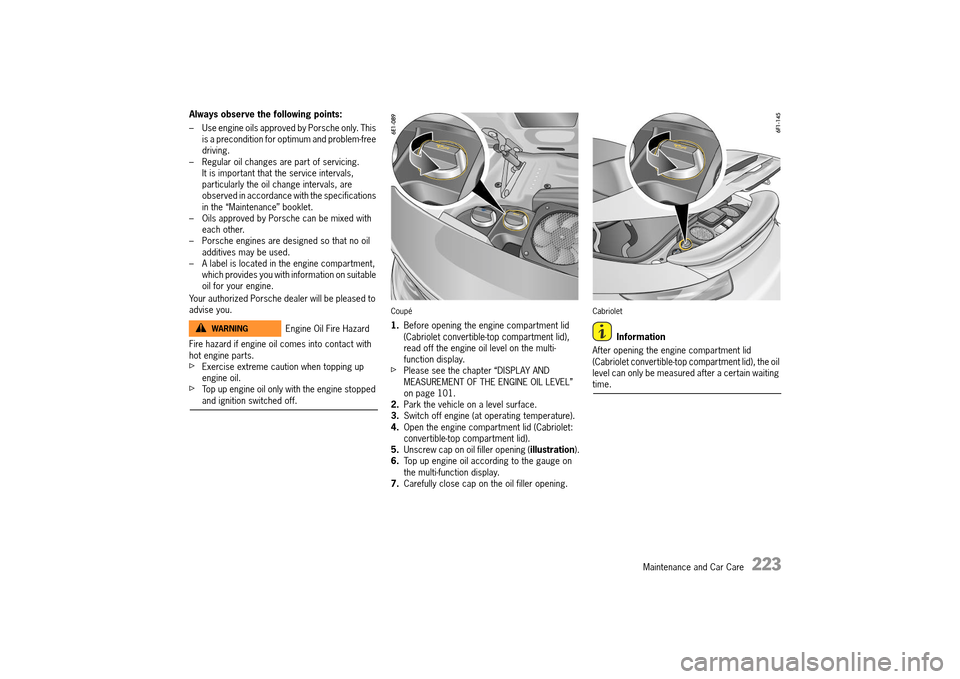
Maintenance and Car Care 223
Always observe the following points:
– Use engine oils approved by Porsche only. This is a precondition for optimum and problem-free driving.– Regular oil changes are part of servicing.It is important that the service intervals, particularly the oil change intervals, are observed in accordance with the specifications in the “Maintenance” booklet.– Oils approved by Porsche can be mixed with each other.– Porsche engines are designed so that no oil additives may be used.– A label is located in the engine compartment, which provides you with information on suitable oil for your engine.
Your authorized Porsche dealer will be pleased to advise you.
Fire hazard if engine oil comes into contact with hot engine parts.fExercise extreme caution when topping up engine oil.fTop up engine oil only with the engine stopped and ignition switched off.
Coupé
1. Before opening the engine compartment lid (Cabriolet convertible-top compartment lid) , read off the engine oil level on the multi-function display.fPlease see the chapter “DISPLAY AND MEASUREMENT OF THE ENGINE OIL LEVEL” on page 101.2. Park the vehicle on a level surface. 3. Switch off engine (at operating temperature). 4. Open the engine compartment lid (Cabriolet: convertible-top compartment lid) . 5. Unscrew cap on oil filler opening (illustration). 6. Top up engine oil according to the gauge on the multi-function display.7. Carefully close cap on the oil filler opening.
Cabriolet
Information
After opening the engine compartment lid (Cabriolet convertible-top compartment lid) , the oil level can only be measured after a certain waiting time.
Engine Oil Fire HazardWARNINGh
14_991_Turbo_21.book Seite 223 Mittwoch, 9. April 2014 2:19 14
Page 226 of 300
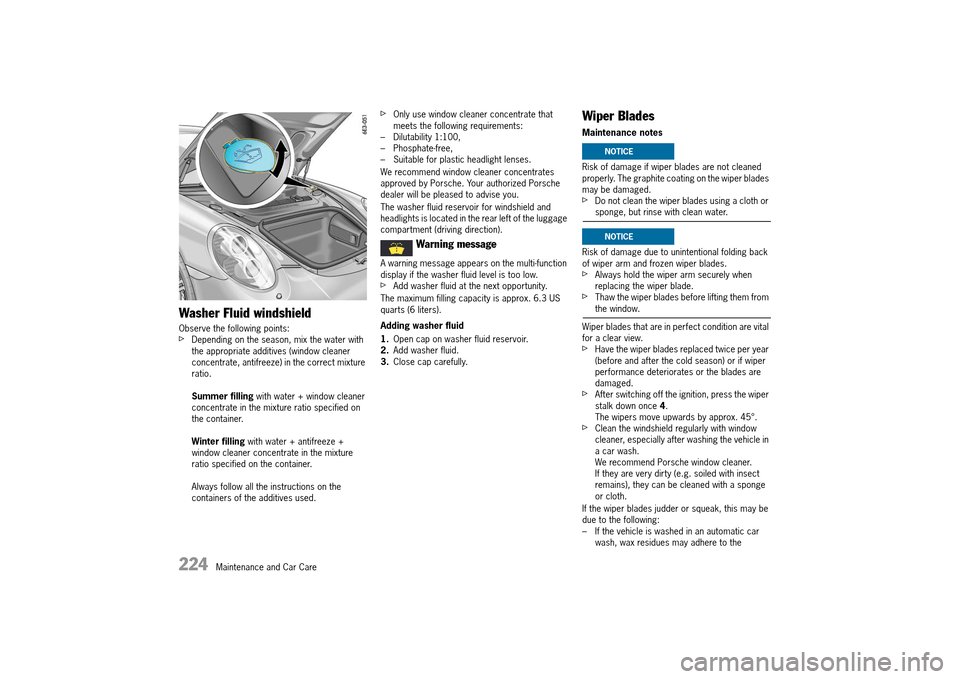
224 Maintenance and Car Care
Washer Fluid windshield
Observe the following points:fDepending on the season, mix the water with the appropriate additives (window cleaner concentrate, antifreeze) in the correct mixture ratio.
Summer filling with water + window cleaner concentrate in the mixture ratio specified on the container.
Winter filling with water + antifreeze + window cleaner concentrate in the mixture ratio specified on the container.
Always follow all the instructions on the containers of the additives used.
fOnly use window cleaner concentrate that meets the following requirements:– Dilutability 1:100,– Phosphate-free,– Suitable for plastic headlight lenses.
We recommend window cleaner concentrates approved by Porsche. Your authorized Porsche dealer will be pleased to advise you.
The washer fluid reservoir for windshield and headlights is located in the rear left of the luggage compartment (driving direction).
A warning message appears on the multi-function display if the washer fluid level is too low.fAdd washer fluid at the next opportunity.
The maximum filling capacity is approx. 6.3 US quarts (6 liters).
Adding washer fluid
1. Open cap on washer fluid reservoir. 2. Add washer fluid. 3. Close cap carefully.
Wiper Blades
Maintenance notes
Risk of damage if wiper blades are not cleaned properly. The graphite coating on the wiper blades may be damaged.fDo not clean the wiper blades using a cloth or sponge, but rinse with clean water.
Risk of damage due to unintentional folding back of wiper arm and frozen wiper blades.fAlways hold the wiper arm securely when replacing the wiper blade.fThaw the wiper blades before lifting them from the window.
Wiper blades that are in perfect condition are vital for a clear view.fHave the wiper blades replaced twice per year (before and after the cold season) or if wiper performance deteriorates or the blades are damaged.fAfter switching off the ignition, press the wiper stalk down once 4. The wipers move upwards by approx. 45°.fClean the windshield regularly with window cleaner, especially after washing the vehicle in a car wash.We recommend Porsche window cleaner. If they are very dirty (e.g. soiled with insect remains), they can be cleaned with a sponge or cloth.
If the wiper blades judder or squeak, this may be due to the following:– If the vehicle is washed in an automatic car wash, wax residues may adhere to the
Warning message
NOTICE
NOTICE
14_991_Turbo_21.book Seite 224 Mittwoch, 9. April 2014 2:19 14
Page 227 of 300

Maintenance and Car Care 225
windshield. These wax residues can be removed only by using window cleaner concentrate.– The wiper blades may be damaged or worn.fHave damaged wiper blades replaced immediately.fPlease see the chapter “WASHER FLUID WINDSHIELD” on page 224.
Replacing wiper blades
fAfter switching off the ignition, press the wiper stalk down once.The wipers move upwards to an angle of approx. 45°.fPlease read the separate instructions provided by the wiper blade manufacturer.fWe recommend that you get your authorized Porsche dealer to replace the wiper blades.
Risk of damage. If the wiper blades are not changed properly, they can come loose when the car is moving.fCheck that the wiper blades are seated securely.The wiper blades must engage properly in the wiper arm.
Emission Control System
In the interest of clean air
Pollution of our environment has become a problem that is of increasing concern to all of us. We urge you to join us in our efforts for cleaner air in controlling the pollutants emitted from the automobile.
Porsche has developed an emission control system that controls or reduces those parts of emissions that can be harmful to our environment. Your Porsche is equipped with such a system.
Porsche warrants the Emission Control System in your new car under the terms and conditions set forth in the Warranty Booklet.
You, as the owner of the vehicle, have the responsibility to provide regular maintenance service for the vehicle and to keep a record of all maintenance work performed. To facilitate record keeping, have services performed by authorized Porsche dealers. They have Porsche trained technicians and special tools to provide fast and efficient service.
To assure efficient operation of the Emission Control System:
fHave your vehicle maintained properly and in accordance with the recommendations described in your Maintenance Booklet. Lack of proper maintenance, as well as improper use of the vehicle, will impair the function of the emission control system and could lead to damage.
fDo not alter or remove any component of the emission control system.fDo not alter or remove any device, such as heat shields, switches, ignition wires, valves, etc., which are designed to protect your vehicle's emission control system. In addition to serious engine damage, this can result in a fire if excess raw fuel reaches the exhaust system.fDo not continue to operate your vehicle if you detect engine misfire or other unusual operating conditions.
Parking
The exhaust system becomes very hot when the engine is running and remains hot for some time after the vehicle is turned off. Flammable material close to the exhaust system could ignite.fDo not park or operate your vehicle in areas where the hot exhaust system may come in contact with dry grass, brush, fuel spill or other flammable materials.fIf your car catches on fire for any reason, call the fire department. Do not endanger your life by attempting to put out the fire.
NOTICE
Fire Risk When ParkingWARNINGh
14_991_Turbo_21.book Seite 225 Mittwoch, 9. April 2014 2:19 14
Page 228 of 300
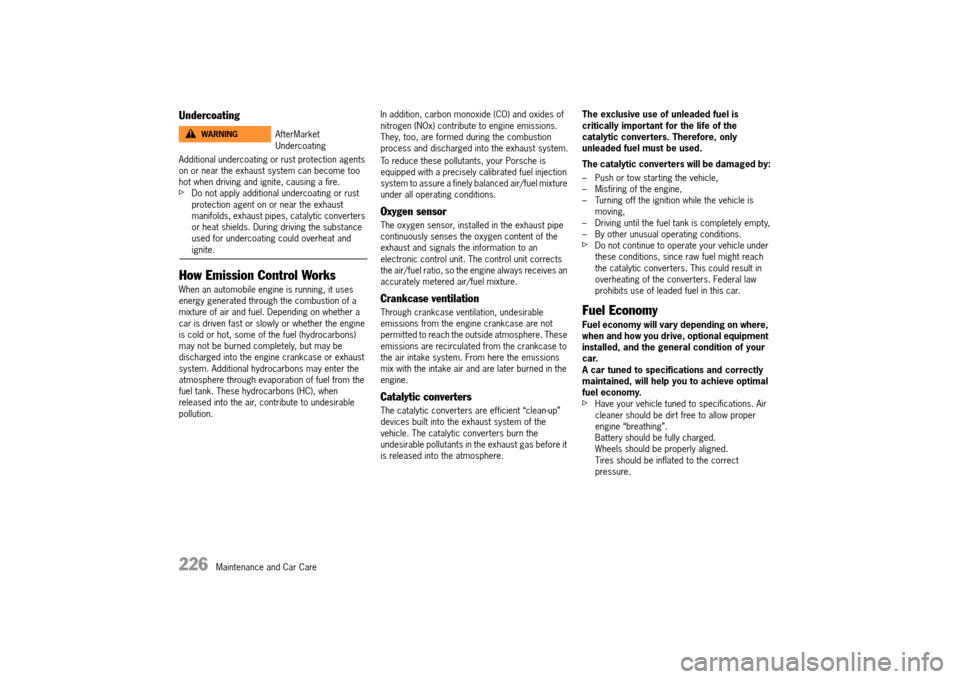
226 Maintenance and Car Care
Undercoating
Additional undercoating or rust protection agents on or near the exhaust system can become too hot when driving and ignite, causing a fire.fDo not apply additional undercoating or rust protection agent on or near the exhaust manifolds, exhaust pipes, catalytic converters or heat shields. During driving the substance used for undercoating could overheat and ignite.
How Emission Control Works
When an automobile engine is running, it uses energy generated through the combustion of a mixture of air and fuel. Depending on whether a car is driven fast or slowly or whether the engine is cold or hot, some of the fuel (hydrocarbons) may not be burned completely, but may be discharged into the engine crankcase or exhaust system. Additional hydrocarbons may enter the atmosphere through evaporation of fuel from the fuel tank. These hydrocarbons (HC), when released into the air, contribute to undesirable pollution.
In addition, carbon monoxide (CO) and oxides of nitrogen (NOx) contribute to engine emissions. They, too, are formed during the combustion process and discharged into the exhaust system.
To reduce these pollutants, your Porsche is equipped with a precisely calibrated fuel injection system to assure a finely balanced air/fuel mixture under all operating conditions.
Oxygen sensor
The oxygen sensor, installed in the exhaust pipe continuously senses the oxygen content of the exhaust and signals the information to an electronic control unit. The control unit corrects the air/fuel ratio, so the engine always receives an accurately metered air/fuel mixture.
Crankcase ventilation
Through crankcase ventilation, undesirable emissions from the engine crankcase are not permitted to reach the outside atmosphere. These emissions are recirculated from the crankcase to the air intake system. From here the emissions mix with the intake air and are later burned in the engine.
Catalytic converters
The catalytic converters are efficient “clean-up” devices built into the exhaust system of the vehicle. The catalytic converters burn the undesirable pollutants in the exhaust gas before it is released into the atmosphere.
The exclusive use of unleaded fuel is critically important for the life of the catalytic converters. Therefore, only unleaded fuel must be used.
The catalytic converters will be damaged by:
– Push or tow starting the vehicle, – Misfiring of the engine,– Turning off the ignition while the vehicle is moving,– Driving until the fuel tank is completely empty,– By other unusual operating conditions.fDo not continue to operate your vehicle under these conditions, since raw fuel might reach the catalytic converters. This could result in overheating of the converters. Federal law prohibits use of leaded fuel in this car.
Fuel Economy
Fuel economy will vary depending on where, when and how you drive, optional equipment installed, and the general condition of your car. A car tuned to specifications and correctly maintained, will help you to achieve optimal fuel economy.fHave your vehicle tuned to specifications. Air cleaner should be dirt free to allow proper engine “breathing”.Battery should be fully charged.Wheels should be properly aligned.Tires should be inflated to the correct pressure.
AfterMarket Undercoating
WARNINGh
14_991_Turbo_21.book Seite 226 Mittwoch, 9. April 2014 2:19 14
Page 229 of 300

Maintenance and Car Care 227
fAlways monitor your fuel consumption.fDrive smoothly, avoid abrupt changes in speed as much as possible.fAvoid jack rabbit starts and sudden stops.fDo not drive longer than necessary in the lower gears. Shifting into a higher gear early without lugging the engine will help save fuel.fProlonged “warm up” idling wastes gas. Start the vehicle just before you are ready to drive. Accelerate slowly and smoothly.fSwitch off the engine if stationary for longer periods.fAny additional weight carried in the vehicle reduces fuel economy. Always keep cargo to a minimum and remove all unnecessary items.fOrganize your trips to take in several errands in one trip.fAll electrical accessories contribute to increased fuel consumption.fOnly switch on the air conditioning when necessary.fDo not drive with the Roof Transport System mounted unless you need it.
The EPA estimated miles per gallon (mpg) is to be used for comparison purposes, actual mileage may be different from the estimated mpg, depending on your driving speed, weather conditions and trip length. Your actual highway mileage may be less than the estimated mpg.fPlease observe all local and national speed limits.
Operating Your Porsche in other
Countries
Government regulations in the United States and Canada require that automobiles meet specific emission regulations and safety standards. Therefore, cars built for the U.S. and Canada differ from vehicles sold in other countries.
If you plan to take your Porsche outside the continental limits of the United States or Canada, there is the possibility that:– Unleaded fuel may not be available,– Unleaded fuel may have a considerably lower octane rating. Excessive engine knock and serious damage to both engine and catalytic converters could result,– Service may be inadequate due to lack of proper service facilities, tools or diagnostic equipment,– Replacement parts may not be available or very difficult to get.
Porsche cannot be responsible for the mechanical damage that could result because of inadequate fuel, service or parts availability.
If you purchased your Porsche abroad and want to bring it back home, be sure to find out about shipping and forwarding requirements, as well as current import and customs regulations.
Fuel
When the ignition is on, the fuel level is displayed on the instrument panel.fPlease see the chapter “FUEL GAUGE” on page 90.
fFire, open flame and smoking are prohibited when handling fuel.
Fuel and fuel vapors are hazardous to health.fAvoid contact with skin or clothing, since injury to your skin may occur.fDo not inhale fuel vapors, since they may make you ill and possibly cause death if inhalation is prolonged and occurs in a closed space.
To prevent damage to the emission control system and engine:fNever drive the tank dry.fAvoid high cornering speeds after the warning lights have come on.
fPlease see the chapter “FUEL ECONOMY” on page 226.
Check engine warning light
If the warning lights in the instrument panel come on and remain on while driving, it suggests: – a potential engine control problem and the need for system service or – an improperly fastened tank cap or
refueling with engine running.
Refueling Fire Risk
Fuel Vapors and Skin Contact
DANGERh
WARNINGh
NOTICE
14_991_Turbo_21.book Seite 227 Mittwoch, 9. April 2014 2:19 14
Page 231 of 300
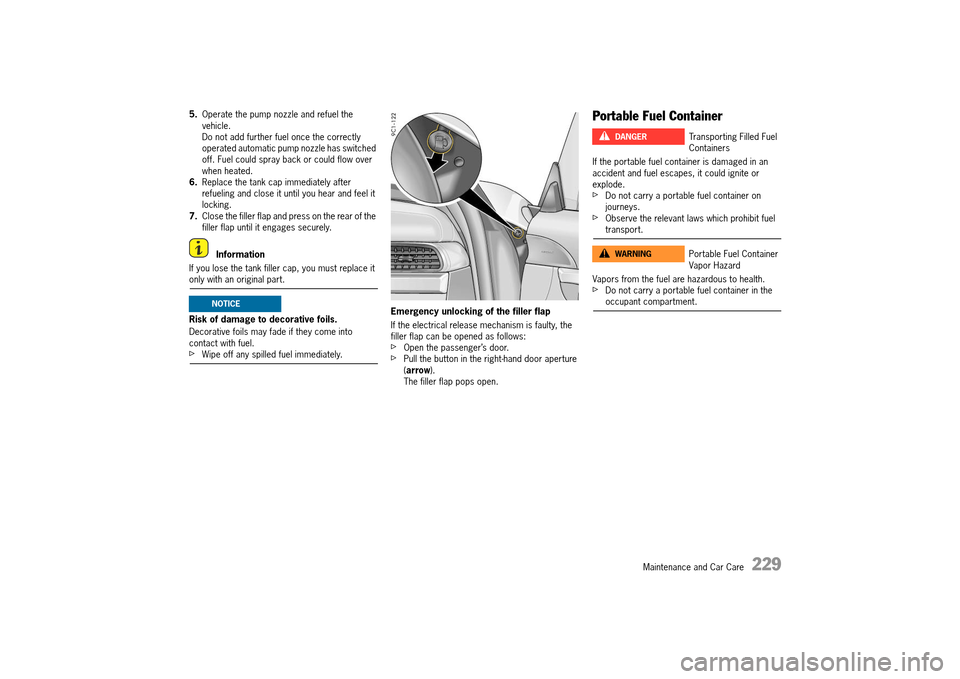
Maintenance and Car Care 229
5.Operate the pump nozzle and refuel the vehicle.Do not add further fuel once the correctly operated automatic pump nozzle has switched off. Fuel could spray back or could flow over when heated.6. Replace the tank cap immediately after refueling and close it until you hear and feel it locking.7. Close the filler flap and press on the rear of the filler flap until it engages securely.
Information
If you lose the tank filler cap, you must replace it only with an original part.
Risk of damage to decorative foils.
Decorative foils may fade if they come into contact with fuel.fWipe off any spilled fuel immediately.
Emergency unlocking of the filler flap
If the electrical release mechanism is faulty, the filler flap can be opened as follows:fOpen the passenger’s door.fPull the button in the right-hand door aperture ( arrow). The filler flap pops open.
Portable Fuel Container
If the portable fuel container is damaged in an accident and fuel escapes, it could ignite or explode.fDo not carry a portable fuel container on journeys.fObserve the relevant laws which prohibit fuel transport.
Vapors from the fuel are hazardous to health.fDo not carry a portable fuel container in the occupant compartment.NOTICE
Transporting Filled Fuel Containers
Portable Fuel Container Vapor Hazard
DANGERh
WARNINGh
14_991_Turbo_21.book Seite 229 Mittwoch, 9. April 2014 2:19 14
Page 233 of 300

Maintenance and Car Care 231
Fuel Evaporation Control
Fuel tank venting
The evaporation chamber and the carbon canister prevent fuel vapors from escaping to the atmosphere at extreme high outside temperatures, when driving abruptly around curves and when the car is parked at an incline or in any other non level position.
Vapor control system and storage
When the fuel tank is filled, vapors are collected in the evaporation chamber by a vent line leading the vapors to the carbon canister where they are stored as long as the engine does not run.
Purge system
When the engine is running, the fuel vapors from the canister will be mixed with fresh air from the ambient air of the canister. This mixture will be directed to the intake air housing by the tank vent line, mixed with the intake air and burned during normal combustion.
Car Care Instructions
fPlease see the chapter “MEASUREMENTS ON TEST STANDS” on page 221.
Regular Maintenance and correct care helps to maintain the value of your car and is also a requirement for maintaining the manufacturers vehicle warranties.
Your authorized Porsche dealer has specially developed car-care products from the Porsche program available either singly or as complete car-care sets. They will be pleased to help you select suitable products.
Whether you use Porsche products or other commercially available cleaning agents first make sure of their correct application.
A Porsche that is well-cared for can look like new for years. It all depends on the amount of care the owner is willing to give the car.
Cleaning agents may be hazardous to your health. Most chemical cleaners are concentrates which require dilution. High concentrations might cause problems ranging from irritation to serious injury.fKeep cleaning agents out of reach from children.fObserve all caution labels.fAlways read directions on the container before using any product. These directions may contain information necessary to avoid personal injury.fDo not use fuel, kerosene, naphtha, nail polish remover or other volatile cleaning fluids. They may be toxic, flammable or hazardous in other ways. Only use spot removing fluids in a well vented area.fDo not clean the underside of chassis, fenders, wheel covers, etc., without protecting your hands and arms as you may cut yourself on sharp-edged metal parts.
Risk of damage to the vehicle or property from cleaning agents.fObserve all caution labels.
Information
Moisture and road salt on brakes may affect braking efficiency. fTest the brakes after each vehicle washing.
Chemical CleanersWARNINGh
NOTICE
14_991_Turbo_21.book Seite 231 Mittwoch, 9. April 2014 2:19 14
Page 234 of 300
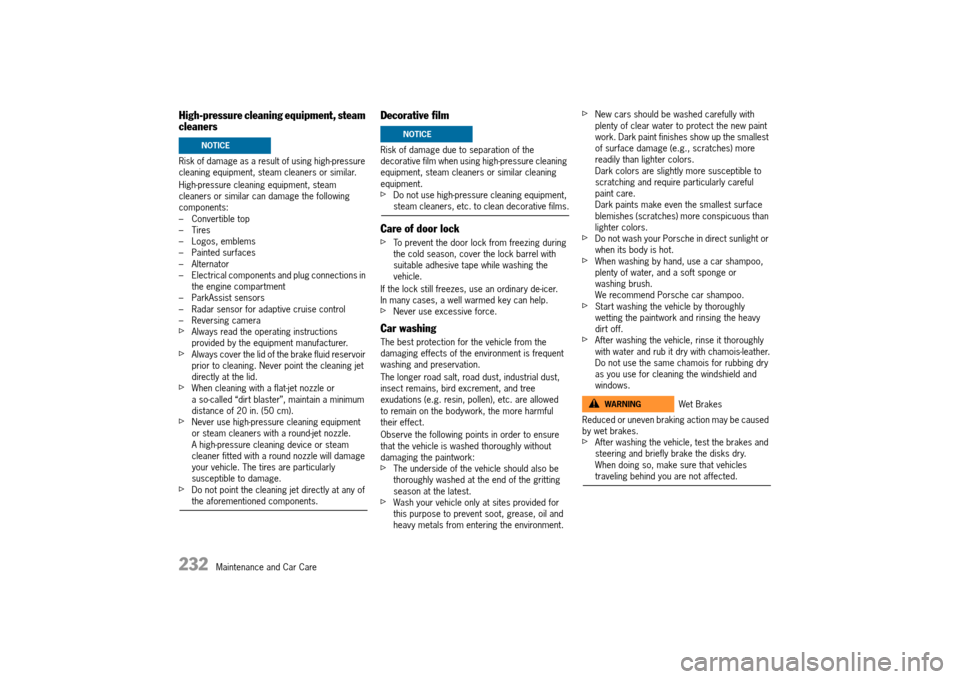
232 Maintenance and Car Care
High-pressure cleaning equipment, steam cleaners
Risk of damage as a result of using high-pressure cleaning equipment, steam cleaners or similar.
High-pressure cleaning equipment, steam cleaners or similar can damage the following components:– Convertible top– Tires– Logos, emblems– Painted surfaces– Alternator– Electrical components and plug connections in the engine compartment– ParkAssist sensors– Radar sensor for adaptive cruise control– Reversing camerafAlways read the operating instructions provided by the equipment manufacturer.fAlways cover the lid of the brake fluid reservoir prior to cleaning. Never point the cleaning jet directly at the lid.fWhen cleaning with a flat-jet nozzle or a so-called “dirt blaster”, maintain a minimum distance of 20 in. (50 cm).fNever use high-pressure cleaning equipment or steam cleaners with a round-jet nozzle.A high-pressure cleaning device or steam cleaner fitted with a round nozzle will damage your vehicle. The tires are particularly susceptible to damage.fDo not point the cleaning jet directly at any of the aforementioned components.
Decorative film
Risk of damage due to separation of the decorative film when using high-pressure cleaning equipment, steam cleaners or similar cleaning equipment.fDo not use high-pressure cleaning equipment, steam cleaners, etc. to clean decorative films.
Care of door lock
fTo prevent the door lock from freezing during the cold season, cover the lock barrel with suitable adhesive tape while washing the vehicle.
If the lock still freezes, use an ordinary de-icer. In many cases, a well warmed key can help.fNever use excessive force.
Car washing
The best protection for the vehicle from the damaging effects of the environment is frequent washing and preservation.
The longer road salt, road dust, industrial dust, insect remains, bird excrement, and tree exudations (e.g. resin, pollen), etc. are allowed to remain on the bodywork, the more harmful their effect.
Observe the following points in order to ensure that the vehicle is washed thoroughly without damaging the paintwork: fThe underside of the vehicle should also be thoroughly washed at the end of the gritting season at the latest.fWash your vehicle only at sites provided for this purpose to prevent soot, grease, oil and heavy metals from entering the environment.
fNew cars should be washed carefully with plenty of clear water to protect the new paint work. Dark paint finishes show up the smallest of surface damage (e.g., scratches) more readily than lighter colors. Dark colors are slightly more susceptible to scratching and require particularly careful paint care.Dark paints make even the smallest surface blemishes (scratches) more conspicuous than lighter colors.fDo not wash your Porsche in direct sunlight or when its body is hot.fWhen washing by hand, use a car shampoo, plenty of water, and a soft sponge or washing brush.We recommend Porsche car shampoo.fStart washing the vehicle by thoroughly wetting the paintwork and rinsing the heavy dirt off.fAfter washing the vehicle, rinse it thoroughly with water and rub it dry with chamois-leather.Do not use the same chamois for rubbing dry as you use for cleaning the windshield and windows.
Reduced or uneven braking action may be caused by wet brakes.fAfter washing the vehicle, test the brakes and steering and briefly brake the disks dry.When doing so, make sure that vehicles traveling behind you are not affected.
NOTICENOTICE
Wet BrakesWARNINGh
14_991_Turbo_21.book Seite 232 Mittwoch, 9. April 2014 2:19 14